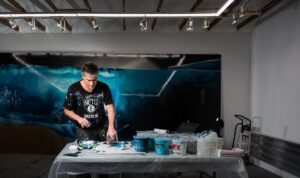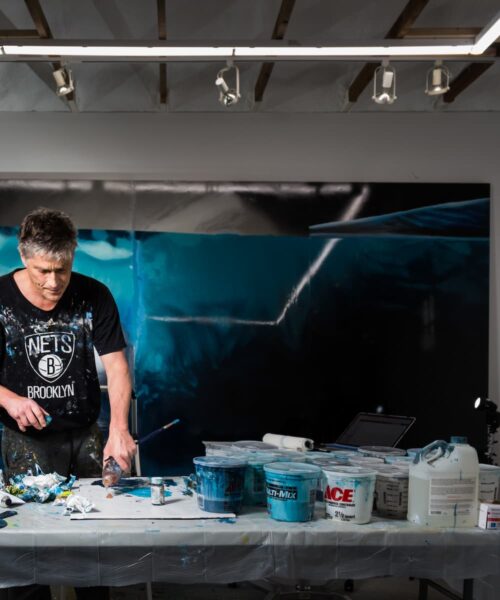February 21, 2023
Artist Alexis Rockman Portrays Our Impact on the Environment
By KK Kozik
When COVID refugees artist Alexis Rockman and his wife, writer Dorothy Spears, first encountered what would become their new home in Warren, they were drawn to several features of the property: a covered bridge spanning a stream between the house and outbuildings, and a garage that with moderate renovations could become a studio just large enough to accommodate Rockman’s newest commission, Oceanus, an 8-by-24-foot painting destined for the Mystic Seaport Museum, where it, accompanied by ten large-scale watercolors, will be permanently installed.
For Oceanus, Rockman, whose single-minded artistic focus has become the deleterious impact of humankind on the environment, was tasked by curator Christina Connett Brophy to take as his starting point the museum itself. A “living museum,” MSM has dedicated its resources to illuminating all facets of man’s historical relationship with the seas, from early vessels and industries through contemporary issues including invasions by some marine species and extinctions of others, human migration and slavery, and crises of climate change.
This is not the first time Rockman has embarked on a project of this scope. While he concentrated in the 80s and 90s on easel-sized paintings, as the emergent nature of climate change entered public consciousness, Rockman arose as one of the premier artists tackling environmental issues, and his scale expanded to epic. He has completed eight paintings of this size, including one for the Smithsonian.
Oceanus is painted in oil and cold wax on linked Dibond segments (an aluminum composite material) that will be disassembled in his studio and reunited in situ. Stylistically it occupies a unique niche. Across its high horizon’s gentle swell sails a timeline flotilla of watercraft (16 painted from models in the MSM collection) that from left to right describe the progress of man on water from canoes through container ships. Below the surface, what Rockman depicts is less benign. Amid the trenches and vents dappled with light, occur a coral reef on the cusp of collapse, seafloor mining, and whale skeletons. This apocalyptic vision describes humanity’s end game with the earth’s oceans. It’s not pretty.
Marine biologist and National Geographic Explorer-in-Residence Sylvie A. Earle asserts in an essay for this project that Rockman’s gift “is seeing what others do not, then artfully sharing the view, skillfully enabling others to feel, understand, and care about what columns of numbers, clever charts, words, and even photographs cannot convey. The message is clear. The ocean is alive and it is in trouble, and therefore, so are we.”
But while the format of this centerpiece painting is somewhat didactic, Rockman’s ocean depths have a mysterious and terrible beauty. Paint—alternately dense and transparent—equates to ocean, enabling the piece to transcend fact-based illustration. Oceanus, as Rockman describes, “synthesizes aspects of multiple pictorial genres that aren’t often seen together: visceral, Ab Ex–like intuitive painting; poured paint; maritime genre ship painting; and natural history illustration.” Oceanus’s message is dire and acute yet its beauty is somehow redemptive. It is not too late, writes Earle, “to find an enduring place for ourselves within the natural systems that sustain us.”























